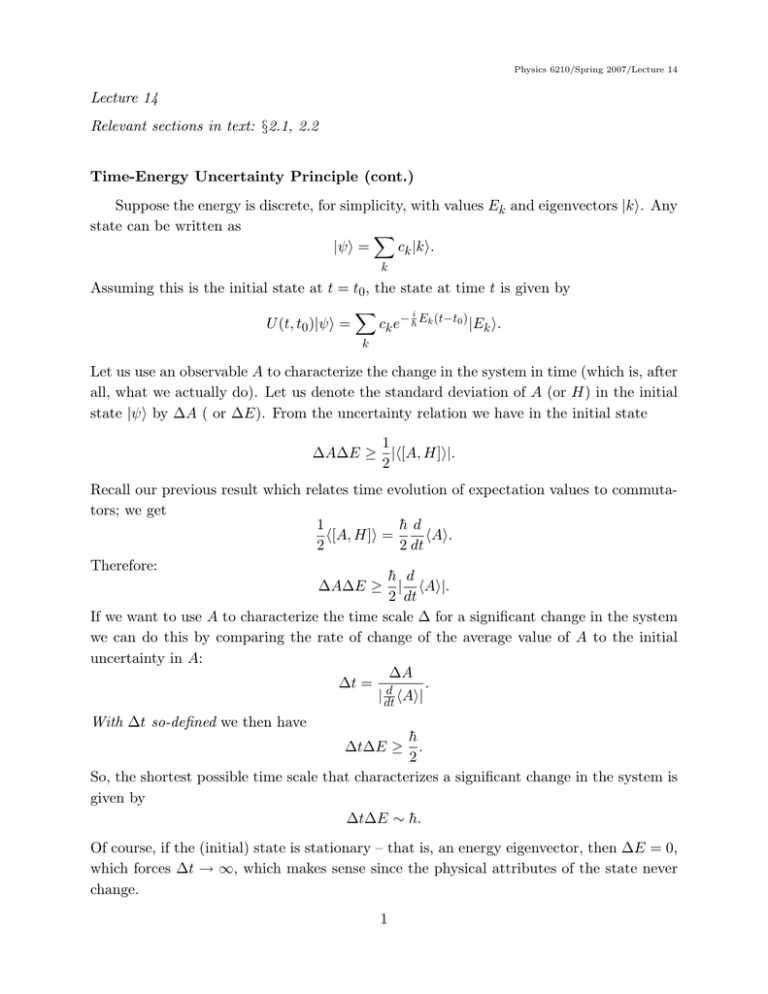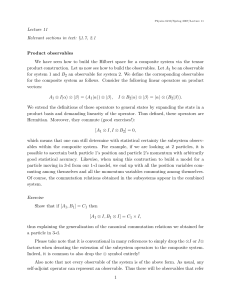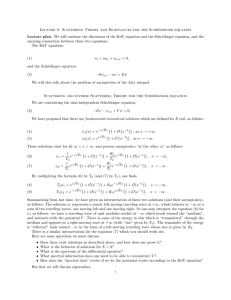Lecture 14 Relevant sections in text: §2.1, 2.2 Time-Energy Uncertainty Principle (cont.)
advertisement

Physics 6210/Spring 2007/Lecture 14 Lecture 14 Relevant sections in text: §2.1, 2.2 Time-Energy Uncertainty Principle (cont.) Suppose the energy is discrete, for simplicity, with values Ek and eigenvectors |ki. Any state can be written as X |ψi = ck |ki. k Assuming this is the initial state at t = t0 , the state at time t is given by X i U (t, t0 )|ψi = ck e− h̄ Ek (t−t0 ) |Ek i. k Let us use an observable A to characterize the change in the system in time (which is, after all, what we actually do). Let us denote the standard deviation of A (or H) in the initial state |ψi by ∆A ( or ∆E). From the uncertainty relation we have in the initial state 1 ∆A∆E ≥ |h[A, H]i|. 2 Recall our previous result which relates time evolution of expectation values to commutators; we get 1 h̄ d h[A, H]i = hAi. 2 2 dt Therefore: h̄ d ∆A∆E ≥ | hAi|. 2 dt If we want to use A to characterize the time scale ∆ for a significant change in the system we can do this by comparing the rate of change of the average value of A to the initial uncertainty in A: ∆A ∆t = d . | dt hAi| With ∆t so-defined we then have h̄ . 2 So, the shortest possible time scale that characterizes a significant change in the system is given by ∆t∆E ∼ h̄. ∆t∆E ≥ Of course, if the (initial) state is stationary – that is, an energy eigenvector, then ∆E = 0, which forces ∆t → ∞, which makes sense since the physical attributes of the state never change. 1 Physics 6210/Spring 2007/Lecture 14 The time-energy uncertainty principle is then a statement about how the statistical uncertainty in the energy (which doesn’t change in time since the energy probability distribution doesn’t change in time) controls the time scale for a change in the system. In various special circumstances this fundamental meaning of the time-energy uncertainty principle can be given other interpretations, but they are not as general as the one we have given here. Indeed, outside of these “special circumstances”, the alternative interpretations of the time-energy uncertainty principle can become ludicrous. What I am speaking of here are things like the oft-heard “You can violate conservation of energy if you do it for a short enough time”, or “The uncertainty of energy is related to the uncertainty in time”. We shall come back to these bizarre sounding statements and see what they really mean a little bit later. For now, beware of such slogans. As a nice example of the time-energy uncertainty principle, consider the spin precession problem we studied last time. Recall that we had a uniform, static magnetic field B = B k̂ along the z axis. The Hamiltonian is H= eB Sz . mc We studied the time dependence of the spin observables when the initial state was an Sx eigenvector. It is not hard to compute the standard deviation of energy in the initial state |Sx , +i. Using eBh̄ 2 2 H = I, 2mc we have (exercise) 1 h̄ eB = h̄ω, 2 mc 2 so that we expect a significant change in the state when ∆E = 1 ω∆t ∼ 1. 2 Thus the frequency ω controls the time scale for changes in the system, as you might have already ascertained from, e.g., the probability distributions h̄ cos2 ( ω2 t) P rob(Sx = ± )(t) = . 2 sin2 ( ω2 t) Heisenberg picture Let us now see how to describe dynamics using the Heisenberg picture, in which we encode the time evolution into the operator representatives of the observables rather than in the state vectors. The idea is that time evolution is mathematically modeled by allowing 2 Physics 6210/Spring 2007/Lecture 14 the correspondence between physical observables and self-adjoint operators to change in time. To see how this works is straightforward, given our previous work in the Schrödinger picture. It is useful to use a very explicit notation. We denote the physical observable by A. We denote its time-independent, self-adjoint operator representative by A. We have* hAi(t) = hψ(t)|A|ψ(t)i = hψ(t0 )|U † (t, t0 )AU (t, t0 )|ψ(t0 )i. If we define A(t) = U † (t, t0 )AU (t, t0 ), then we can view time evolution as occurring, mathematically speaking, through the time dependent identification of a self-adjoint operator A(t) to the observable A: hAi(t) = hψ(t0 )|A(t)|ψ(t0 )i. We call A the Schrödinger picture operator/observable and we call A(t) the Heisenberg picture operator/observable. You can see that at t = t0 the Schrödinger and Heisenberg representatives of A are the same. In the Heisenberg picture the unit vector representing the state of the system is fixed once and for all, |ψ(t)i = |ψ(t0 )i, while the operator-observables evolve in time. In the Schrödinger picture the states evolve in time while the operator-observables are held fixed. As you know, one of the most basic predictions of quantum mechanics is that the set of possible outcomes of a measurement of A is the spectrum of its operator representative. In the Schrödinger picture, we thus consider the spectrum of A to get at the possible outcomes of a measurement of A. In the Heisenberg picture, we have to, evidently, consider a different operator at each time to see what are the possible outcomes of a measurement of A at each time. This looks bad. If, in the Heisenberg picture, the operator representing A can, in principle, be different at different times, we are in danger of saying that the possible outcomes of a measurement of A – which is a fixed set for all time in the Schrödinger picture – is different at different times. For example, perhaps it is possible that a particle could, at one instant of time, have the whole real line to move on while it could only move on some subset of the real line at some other time. This would be a serious inconsistency. * For simplicity, we shall always restrict our attention to observables A which do not involve the time t explicitly in their definition. What I mean here is that we shall exclude from our discussion observables like “the energy multiplied by the time”. It is easy to allow for such observables, but it might be confusing at first glance. Your text shows how to generalize our results to the case of “explicitly time dependent observables”. 3 Physics 6210/Spring 2007/Lecture 14 Of course, there is no inconsistency. You can easily check that if |ai i are the eigenvectors of A, A|ai i = ai |ai i, then |ai (t)i := U † (t, t0 )|ai i are eigenvectors of A(t) with the same eigenvalue: A|ai (t)i = ai |ai (t)i. In fact, it is not hard to prove that the spectrum of A(t) is identical to the spectrum of A.* Thus the possible outcomes of a measurement of A are the same in both pictures. What does change between the two pictures is the mathematical representation of the states in which the observable A is fixed with statistical certainty. As you know, the states where A are known with certainty are the eigenvectors of the operator representative. In the Heisenberg picture we then get, in general, a different eigenvector at each time. This is exactly what is needed to get the proper time evolution of probability distributions: P rob(A = ai ) = |hai (t)|ψ(t0 )i|2 = |hai |U (t, t0 )|ψ(t0 )i|2 = |hai |ψ(t)|i|2 , where the last expression is the Schrödinger picture formula for the probability. This result on the eigenvectors changing in time can lead to confusion, so let me belabor the point a bit. The state vector in the Heisenberg picture is the same for all time, but the (basis of) eigenvectors of an observable will, in general, change in time. If you start your system off in an eigenvector of A(t0 ), this means that the observable A is known with certainty at time t = t0 and we have |ψ(t)i = |ψ(t0 )i = |a(t0 )i. At some other time t, the state vector is still |a(t0 )i, but this is no longer a state in which A is known with certainty since that state vector would be |a(t)i, not |a(t0 )i. One sometimes summarizes this situation with the slogan: In the Schrödinger picture the basis vectors (provided by the observables) are fixed, while the state vector evolves in time. In the Heisenberg picture the state vectors are held fixed, but the basis vectors evolve in time (in the inverse manner). This is an instance of the “active vs. passive” representation of a transformation — in this case time evolution. * This is true for any two operators related by a unitary transformation A ↔ U † AU . 4







